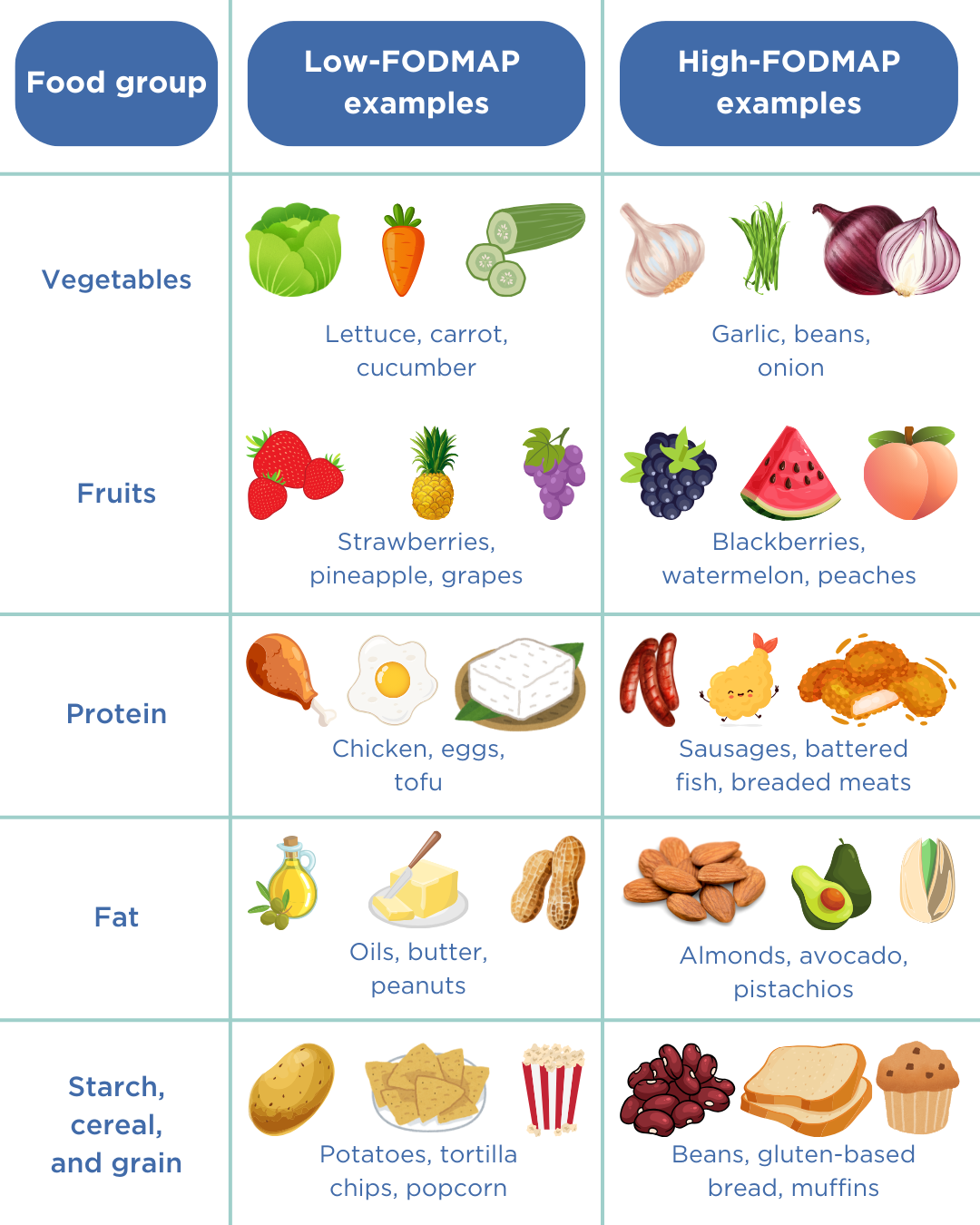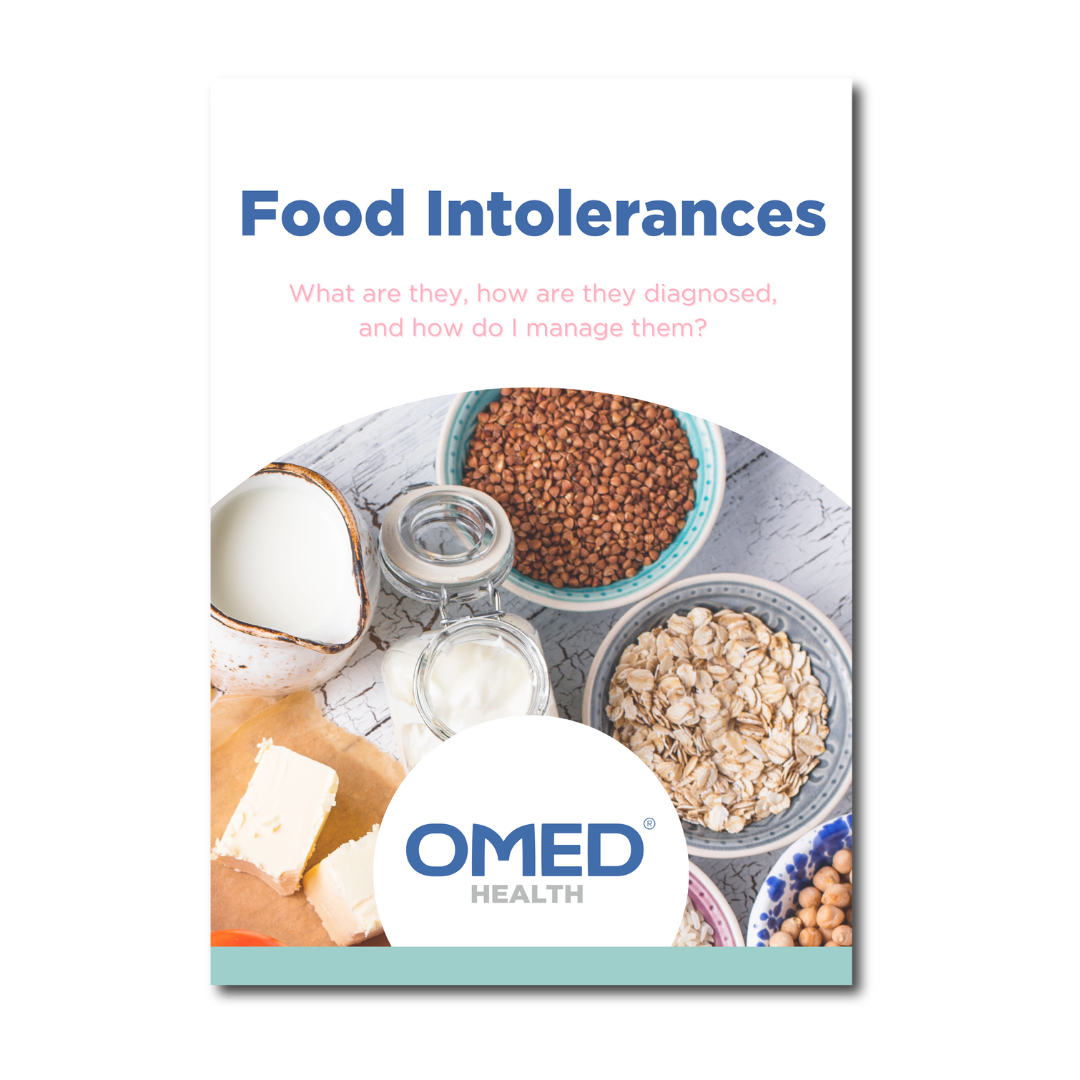You may have heard that prebiotics are good for your gut health. However, if you are on a low-FODMAP diet, it can be difficult to eat enough prebiotic foods. Let’s explore how prebiotics and the low-FODMAP diet are linked and why it is important to find the balance between the two.
What is the low-FODMAP diet?
FODMAP stands for fermentable oligosaccharides, disaccharides, monosaccharides, and polyols. These are short-chain carbohydrates (sugars) found in a wide variety of foods and are poorly absorbed by the small intestine. When these sugars are broken down by bacteria in the gut, gas is produced, causing some individuals to experience bloating, cramping, and diarrhea.
Therefore, the low-FODMAP diet is designed to help people with gut disorders figure out which foods are causing them problems. It is a three-step elimination diet:
- Stop eating certain foods (high-FODMAP foods).
- Slowly reintroduce them to identify which ones are causing trouble.
- Once identified, avoid, or limit the intake of the food to hopefully see a reduction in symptoms (1).
The low-FODMAP diet is popular in patients with irritable bowel syndrome (IBS) and small intestinal bacterial overgrowth (SIBO). This is because research has shown that the low-FODMAP diet can reduce symptoms of these disorders in up to 86% of people (2).
It is important to talk to your doctor before starting a new diet, especially when thinking about the low-FODMAP diet since step 1 eliminates many foods. This could be particularly difficult and potentially harmful if you already follow certain restrictions, such as a vegan diet.
The four categories of FODMAPs are also often rich sources of fiber. There is a key difference between ‘normal’ fiber and FODMAP fiber – they have different chemical structures, meaning they are broken down by the gut microbiome at different speeds. The fiber seen in FODMAPs has very short chain lengths, meaning they are broken down very quickly by the gut microbiome, and gas is produced at a fast rate. ‘Normal’ fiber has longer chain lengths and is therefore broken down at a slower and steadier rate (3).
When gas is produced at a fast rate, symptoms such as bloating can occur. This could explain why a reduction in symptoms is often seen in individuals following the low-FODMAP diet – it is low in fiber. However, there is a certain type of fiber that is super beneficial for our bodies. Let’s find out…
What are prebiotics?
Prebiotics are types of fiber that are not digested in the gastrointestinal tract but are fermented by the bacteria in our gut, known as the gut microbiome. This means that prebiotics stimulate the growth and activity of healthy bacteria in the gut. We can think of prebiotics as our healthy gut bacteria’s favorite food! We want to feed these bacteria because they have several health benefits, such as:
- Defending us from harmful disease-causing bacteria.
- The products of their fermentation, such as short-chain fatty acids (SCFAs) can help to prevent certain gastrointestinal diseases (4).
- Regulating the immune system (5).
The health benefits of prebiotics are still being investigated, however, there is good evidence to suggest that they have a positive impact on our overall gut health. Prebiotics can help to maintain the balance of healthy bacteria in the gut and improve the absorption of vitamins and minerals in the gut (6).

Prebiotics and the low-FODMAP diet
Because prebiotics are often found in FODMAP-containing foods, people following the low-FODMAP diet often accidentally limit their intake of prebiotics. This reduces the amount of food available for the healthy bacteria in our gut. Studies that have investigated the effect of a low-FODMAP diet on gut bacteria have shown that both the amount and variety of good bacteria decreased in the gut during the elimination stage of the low-FODMAP diet (where all FODMAP foods are eliminated from the diet) (7).
But there is no need to panic! Most patients following the low-FODMAP diet are normally only in the elimination phase of the diet for a few weeks – meaning some FODMAP foods will be reintroduced and therefore prebiotic intake increases. Many low-FODMAP foods are classed as prebiotics too. These foods are the best of both worlds! Below are some examples.
Low-FODMAP prebiotic foods
- Cabbage (red and common – 3/4 of a cup) – check out our low-FODMAP friendly recipe that uses cabbage, a delicious Prawn Pad Thai.
- Cabbage (savoy –1/2 of a cup)
- Fennel (1/2 of a cup)
- Eggplant (1 cup)
- Butternut squash (1/3 of a cup) – check out our low-FODMAP friendly recipe that uses butternut squash, a yummy Butternut Squash and Carrot Soup.
- Chickpeas (1/4 of a cup)
- Lentils (1/2 of a cup)
- Kiwi (2 small)
- Unripe banana (1 medium)
- Pomegranate (45g)
- Grapefruit (1/2 a medium)
- Buckwheat flour (up to 100g)
- Oats (1/2 cup)
- Almonds (12g) – check out our low-FODMAP-friendly recipes that use almonds, a tasty Smoothie Breakfast Bowl, and Peanut Butter Flapjacks (a favorite here at OMED Health!)

It is important to note that combining too many of these low-FODMAP servings into one meal may add up to an overall higher FODMAP meal. It is all about balance. Also, adding smaller servings of high-FODMAP prebiotic foods to a meal can be considered low-FODMAP. Discussing your diet with a healthcare professional can help identify your fiber tolerance level and find the right balance for your gut.
If you find it hard to consume enough prebiotic fiber in your diet whilst following a low-FODMAP diet, there are FODMAP-friendly prebiotic supplements that you can purchase over the counter. You may have heard of another supplement called probiotics. If you want to know more about probiotics, read our blog here. However, it is important to discuss this with your healthcare provider before introducing any kind of supplement to your diet.
How can OMED Health help?
Everyone’s gut microbiome is different, meaning prebiotics and the low-FODMAP diet may work for some people, but not for you. At OMED Health we understand how important it is for individuals to have insight into their gut health and be able to monitor what is going on inside their bodies. We have developed the OMED Health Breath Analyzer and App, an at-home breath-testing device that enables the monitoring of key gut microbiome-associated gases in the breath alongside tracking lifestyle factors such as your diet in the app.
Our app also features a food diary where you can record your intake of food and any symptoms you are experiencing. This means you can see the effects of things such as a low-FODMAP diet and prebiotics on your gut health. You can join the waitlist for the device and app here.
References
- Sultan N, Varney JE, Halmos EP, Biesiekierski JR, Yao CK, Muir JG, et al. How to Implement the 3-Phase FODMAP Diet Into Gastroenterological Practice. J Neurogastroenterol Motil. 2022 Jul 30;28(3):343–56. DOI: 10.5056/jnm22035
- Nanayakkara WS, Skidmore PM, O’Brien L, Wilkinson TJ, Gearry RB. Efficacy of the low FODMAP diet for treating irritable bowel syndrome: the evidence to date. Clin Exp Gastroenterol. 2016 Jun 17;9:131–42. DOI: 10.2147/CEG.S86798
- Cummings J. H., Macfarlane G T. The control and consequences of bacterial fermentation in the human colon. Journal of Applied Bacteriology. 1991;70(6):443–59. DOI: 10.1111/j.1365-2672.1991.tb02739.x
- Son MY, Cho HS. Anticancer Effects of Gut Microbiota-Derived Short-Chain Fatty Acids in Cancers. J Microbiol Biotechnol. 2023 Jul 28;33(7):849–56. DOI: 10.4014/jmb.2301.01031
- Yoo JY, Groer M, Dutra SVO, Sarkar A, McSkimming DI. Gut Microbiota and Immune System Interactions. Microorganisms. 2020 Oct 15;8(10):1587. DOI: 10.3390/microorganisms8101587
- Slavin J. Fiber and Prebiotics: Mechanisms and Health Benefits. Nutrients. 2013 Apr;5(4):1417–35. DOI: 10.3390/nu5041417
- Vandeputte D, Joossens M. Effects of Low and High FODMAP Diets on Human Gastrointestinal Microbiota Composition in Adults with Intestinal Diseases: A Systematic Review. Microorganisms. 2020 Oct 23;8(11):1638. DOI: 10.3390/microorganisms8111638




